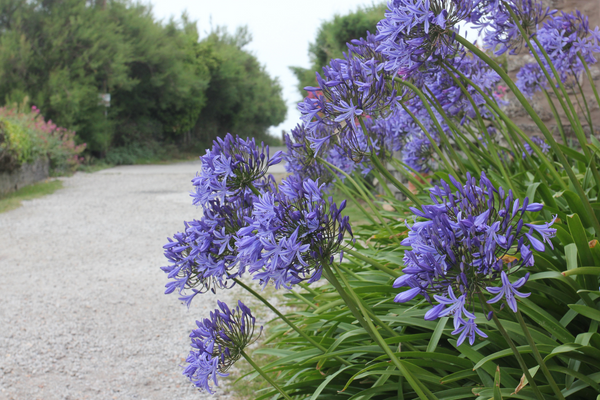
What We've Included
When to Plant | How to Plant | Where to Plant | After Care |
Common Issues | When will they flower | Inspiration
When to Plant
We sell Agapanthus in several formats, from loose roots to pot-grown plants. However, the best time to plant them doesn’t differ based on these. We suggest planting your Agapanthus in late Autumn or Spring, although they may require some protection from heavy frost. Add some extra on top of the soil where they’ve been planted to keep them warm.
How to Plant

Loose Roots
Loose roots to beginners might sound intimidating but are in fact, incredibly easy to plant! Here’s how to do it from mid-Spring.
- Soak roots in a bucket of water for 1-2 hours before planting.
- Dig a hole in the border that’s big enough to house the root system. If planting in pots, fill a large pot halfway with potting soil and then pop the roots in with the crown pointing upwards and the root system pointing to the floor.
- Plant in groups for a fuller display, usually in groups of 3, somewhere that gets plenty of sunlight.
- Ensure the crown is just below the soil unless the plant has some leaves, in which case leave them exposed with the rest of the root system under the soil.
- Water well once planted.

Pot Grown Plants
Even easier to plant than loose roots (which is saying something!) are our pot-grown plants.
Whether you’re growing them directly outside into the border or into a container, our pot-grown plants are a breeze from the moment they arrive.
- Dig a hole in the border that’s big enough to house the root system. If planting in pots, fill a large pot halfway with potting soil and then make a well in the middle. Do this until the top of the soil from the plant is just below the top of the pot.
- Wedge in the plant by adding soil to the gaps in the hole, firming down the surface to ensure it’s in place.
- Water well and you’re done!
Tip: The natural habitat of the Agapanthus is a rocky site in full sun. With that in mind, make sure you plant them in a site that drains well. You can improve the soil’s drainage by adding grit or pebbles into the bottom of your planting hole or at the bottom of pots.
Where to Plant
Position Agapanthus in areas that reach plenty of sunlight, whether that be in a sunny border or container. In fact, it’s said that Agapanthus grow better when their roots are constricted, like in a container.
Agapanthus plants will grow well in rockeries or in coastal areas – the harsh winds won’t bother them at all.

After Care
When to water
Water Agapanthus regularly in their first year after planting. Plants grown in pots will need watering more often than those grown in the flower bed, so make sure that you check if their soil is dry regularly.
What to do once they have finished blooming
Agapanthus plants will survive the winter but may need different levels of protection depending on the variety.
Fine leaf herbaceous varieties, usually supplied as loose rooted plants, are generally more resilient from frosts in more sheltered areas. However, in more exposed locations, plants can be protected from a severe winter by covering them with straw and mulch or by lifting and storing them somewhere cool and dry.
Broad leaf evergreen varieties, which are often more expensive varieties supplied in pots such as, Agapanthus Fireworks, Agapanthus Twister, and Agapanthus Queen Mum, may need winter protection.
Owner of J. Parker’s, Paul Parker, recommends planting broad leaf varieties in containers so they can be moved into a more sheltered environment. “I move my pots alongside a sheltered wall; however, a frost-free glass house would be perfect”.
Storing tips
1. Wait until the plant has died down and has reached a straw colour (often brown).
2. Cut down the plant to the bottom of the stem and gently dig up the plant. Shake off any remaining soil.
3. Pot your Agapanthus up and store them in a cool, dry place until it’s time to replant them outside when the threat of frost has passed (often late April to May).
Deadheading
Deadheading Agapanthus flowers can help the plant regrow new ones, keeping your displays looking full and healthy for longer.
To deadhead your flowers or to cut them for indoor bouquets, simply cut the spent flower with clean shears, just above the leaves.

Common issues and how to solve them
When grown in the right place, Agapanthuses aren’t subject to many pests. However, if you’re wondering ‘why isn’t my Agapanthus flowering?’ then it’s most likely because the roots have too much room to grow. Consider moving them to a smaller pot if they’re in a large one. Newly transplanted plants often take around 12 months to establish, giving the roots enough time to spread and constrict enough to promote flowering.
When will they flower?
Agapanthuses have a long flowering period, lasting for months on end. They’re a perfect pick for gardens that need a boost of colour, particularly toward the end of the summer and into early autumn.
Ready to Shop?
Find some inspiration for your garden
